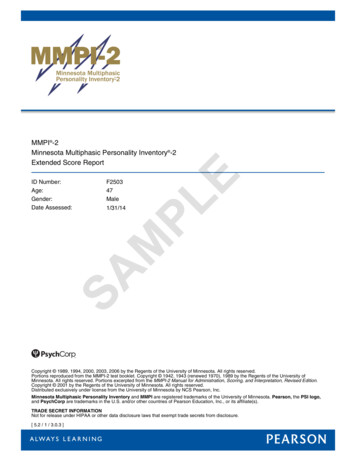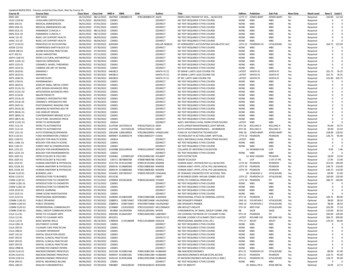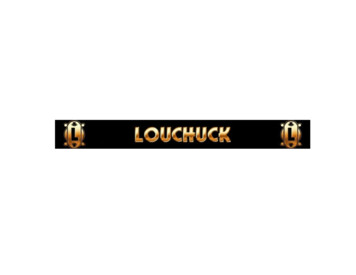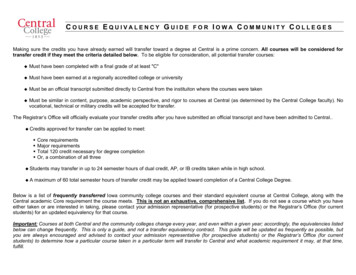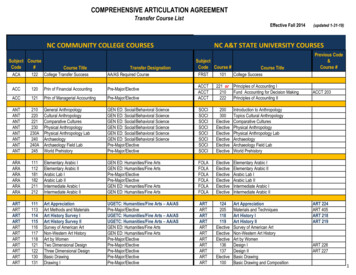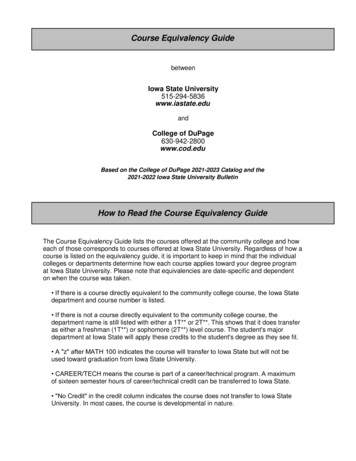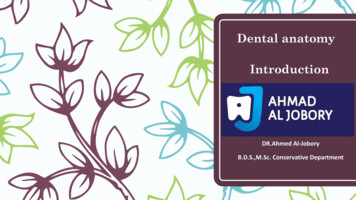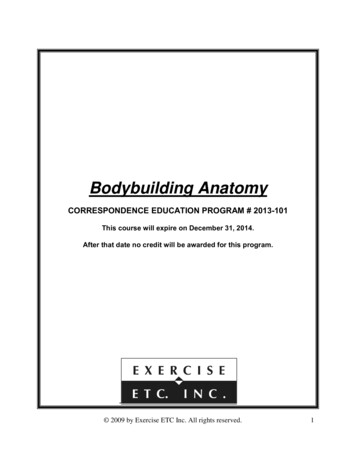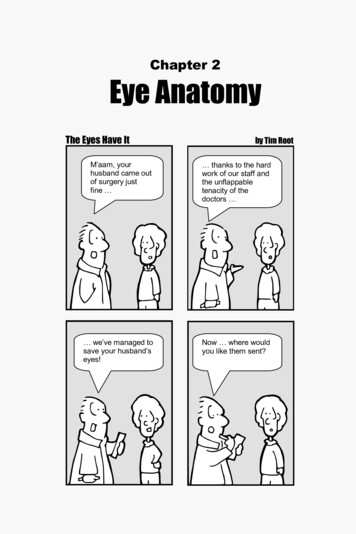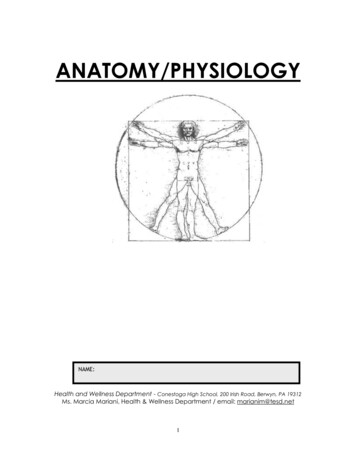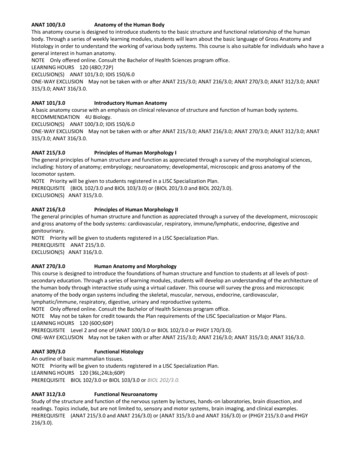
Transcription
ANAT 100/3.0Anatomy of the Human BodyThis anatomy course is designed to introduce students to the basic structure and functional relationship of the humanbody. Through a series of weekly learning modules, students will learn about the basic language of Gross Anatomy andHistology in order to understand the working of various body systems. This course is also suitable for individuals who have ageneral interest in human anatomy.NOTE Only offered online. Consult the Bachelor of Health Sciences program office.LEARNING HOURS 120 (48O;72P)EXCLUSION(S) ANAT 101/3.0; IDIS 150/6.0ONE-WAY EXCLUSION May not be taken with or after ANAT 215/3.0; ANAT 216/3.0; ANAT 270/3.0; ANAT 312/3.0; ANAT315/3.0; ANAT 316/3.0.ANAT 101/3.0Introductory Human AnatomyA basic anatomy course with an emphasis on clinical relevance of structure and function of human body systems.RECOMMENDATION 4U Biology.EXCLUSION(S) ANAT 100/3.0; IDIS 150/6.0ONE-WAY EXCLUSION May not be taken with or after ANAT 215/3.0; ANAT 216/3.0; ANAT 270/3.0; ANAT 312/3.0; ANAT315/3.0; ANAT 316/3.0.ANAT 215/3.0Principles of Human Morphology IThe general principles of human structure and function as appreciated through a survey of the morphological sciences,including: history of anatomy; embryology; neuroanatomy; developmental, microscopic and gross anatomy of thelocomotor system.NOTE Priority will be given to students registered in a LISC Specialization Plan.PREREQUISITE (BIOL 102/3.0 and BIOL 103/3.0) or (BIOL 201/3.0 and BIOL 202/3.0).EXCLUSION(S) ANAT 315/3.0.ANAT 216/3.0Principles of Human Morphology IIThe general principles of human structure and function as appreciated through a survey of the development, microscopicand gross anatomy of the body systems: cardiovascular, respiratory, immune/lymphatic, endocrine, digestive andgenitourinary.NOTE Priority will be given to students registered in a LISC Specialization Plan.PREREQUISITE ANAT 215/3.0.EXCLUSION(S) ANAT 316/3.0.ANAT 270/3.0Human Anatomy and MorphologyThis course is designed to introduce the foundations of human structure and function to students at all levels of postsecondary education. Through a series of learning modules, students will develop an understanding of the architecture ofthe human body through interactive study using a virtual cadaver. This course will survey the gross and microscopicanatomy of the body organ systems including the skeletal, muscular, nervous, endocrine, cardiovascular,lymphatic/immune, respiratory, digestive, urinary and reproductive systems.NOTE Only offered online. Consult the Bachelor of Health Sciences program office.NOTE May not be taken for credit towards the Plan requirements of the LISC Specialization or Major Plans.LEARNING HOURS 120 (60O;60P)PREREQUISITE Level 2 and one of (ANAT 100/3.0 or BIOL 102/3.0 or PHGY 170/3.0).ONE-WAY EXCLUSION May not be taken with or after ANAT 215/3.0; ANAT 216/3.0; ANAT 315/3.0; ANAT 316/3.0.ANAT 309/3.0Functional HistologyAn outline of basic mammalian tissues.NOTE Priority will be given to students registered in a LISC Specialization Plan.LEARNING HOURS 120 (36L;24Lb;60P)PREREQUISITE BIOL 102/3.0 or BIOL 103/3.0 or BIOL 202/3.0.ANAT 312/3.0Functional NeuroanatomyStudy of the structure and function of the nervous system by lectures, hands-on laboratories, brain dissection, andreadings. Topics include, but are not limited to, sensory and motor systems, brain imaging, and clinical examples.PREREQUISITE (ANAT 215/3.0 and ANAT 216/3.0) or (ANAT 315/3.0 and ANAT 316/3.0) or (PHGY 215/3.0 and PHGY216/3.0).
ANAT 315/3.0The Human Musculoskeletal SystemGross and functional anatomy of the back, body wall, upper and lower limbs, including blood supply and neural controls.PREREQUISITE (BIOL 102/3.0 and BIOL 103/3.0) or (BIOL 201/3.0 and BIOL 202/3.0) or KNPE 153/3.0 or PHED 153/3.0.EXCLUSION(S) ANAT 215/3.0.ANAT 316/3.0The Human Visceral SystemsGross and functional anatomy of the thorax, abdomen and pelvis, head and neck.PREREQUISITE (BIOL 102/3.0 and BIOL 103/3.0) or (BIOL 201/3.0 and BIOL 202/3.0) or KNPE 153/3.0 or PHED 153/3.0.EXCLUSION(S) ANAT 216/3.0.ANAT 380/3.0Clinically Relevant Human AnatomyANAT 380 will explore regional anatomy of the human body focusing on the major organ systems, their components, andthe relationships between them. In this course, students will apply anatomical knowledge to collaboratively solve casebased clinical scenarios, and develop a realistic clinical case based on an underlying anatomical issue.LEARNING HOURS 120(48O;72P)PREREQUISITE {Minimum 3rd year (level 3) standing, and one of [ANAT 100/3.0; ANAT 101/3.0; (ANAT 215/3.0 and ANAT216/3.0);(ANAT 315/3.0 and ANAT 316/3.0)]; and one of [(PHGY 215/3.0 and PHGY 216/3.0);(KNPE 125/3.0 and KNPE225/3.0)]}OR{Minimum 2nd year (level 2) standing in a KINE Plan, and one of [ANAT 100/3.0; ANAT 101/3.0; (ANAT 215/3.0 and ANAT216/3.0);(ANAT 315/3.0 and ANAT 316/3.0)]; and one of [(PHGY 215/3.0 and PHGY 216/3.0);(KNPE 125/3.0 and KNPE225/3.0)]}ANAT 409/3.0Selected Topics in HistologyA focused histological and cell biological study of three selected mammalian tissues, organs and/or systems.PREREQUISITE Level 4 and a GPA of 2.5 and (registration in a LISC Major or Specialization Plan) and [ANAT 309/3.0 or(ANAT 215/3.0 and ANAT 216/3.0) or (ANAT 315/3.0 and ANAT 316/3.0)].ANAT 417/3.0Mammalian Embryonic DevelopmentComprehensive overview of cellular and molecular mechanisms that direct embryogenesis including gastrulation,neurulation, establishment of body axes, differentiation, sex determination, limb development, organogenesis, andteratology. Participation in seminar presentations and group discussions is required.LEARNING HOURS 114 (24L;12S;1I;77P)PREREQUISITE Level 4 and a GPA of 2.5 and (registration in a LISC Major or Specialization Plan) and [ANAT 309/3.0 or(ANAT 215/3.0 and ANAT 216/3.0) or (ANAT 315/3.0 and ANAT 316/3.0)].ANAT 499/12.0Research Project in Anatomy and Cell BiologyAn examination of the development and present state of knowledge in selected research areas of Anatomy and CellBiology. Research project involves experimental design, data collection and analysis, written report, poster presentationand oral presentation. Students will be required to attend seminars and tutorials on topics related to research. Limitedenrolment; restricted to fourth year honours, permission of the department required.NOTE Acceptance by a supervisor required prior to registration.NOTE Students whose research requires the care and/or handling of animals must also complete the Introductory AnimalCare Course and if required the appropriate Animal Use workshops through the Office of the University Veterinarian.LEARNING HOURS 480 (288Lb;24G;24I;144P)PREREQUISITE Level 4 and registration in a LISC Specialization Plan and a GPA of 2.50 and [(ANAT 215/3.0 and ANAT216/3.0) or ANAT 309/3.0 or (ANAT 315/3.0 and ANAT 316/3.0)].EXCLUSION(S) CANC 499/12.0; EPID 499/12.0; LISC 499/12.0; MICR 499/12.0; NSCI 499/12.0; PATH 499/12.0; PHAR499/12.0; PHGY 499/12.0; REPD 499/12; MICR 455/6.0.
ANSH 101/3.0Beginning Anishinaabe Language and Culture IAn introduction to the language and culture of the Anishinaabe people. This course is designed for those who have neitherbeen exposed to Anishinaabemowin nor its traditional societal practices. Gain a rich understanding of the Anishinaabepeople and their language at the beginning level.LEARNING HOURS 120 (36L;84P)EXCLUSION(S) LLCU 101/3.0 (Anishinaabemowin I).ANSH 102/3.0Beginning Anishinaabe Language and Culture IIA continuation of ANSH 101/3.0. Students will participate and begin to develop the ability to read, write and speak somebasic Anishinaabemowin and further their understanding of the rich culture, traditions and worldviews of the Anishinaabepeople.LEARNING HOURS 120 (36L;84P)PREREQUISITE ANSH 101/3.0.EXCLUSION(S) LLCU 102/3.0 (Anishinaabemowin I).
ARAB 100/6.0Introductory Arabic (Modern Standard)Introduction to the basic structures of Modern Standard Arabic. This course gives intensive training equally in listening,speaking, reading, and writing.LEARNING HOURS 240 (72L;168P)PREREQUISITE Permission of the Instructor.ARAB 200/6.0Intermediate Modern Standard ArabicThis intensive intermediate-level course is designed to provide a review of the basic elements of Modern Standard Arabicand continues the development of students’ communicative skills in reading, writing, listening and speaking Arabic. It willoffer an introduction to more complex syntactic and grammatical forms and structures, preparing students for carrying on asimple conversation, reading an intermediate level text, and understanding basic conversations.LEARNING HOURS 240 (72L;168P)PREREQUISITE ARAB 100/6.0 or permission of the Instructor.
ARTF 100/6.0Introductory DrawingA basic introduction to the principles of line and form, intended as a foundation for further studies in the visual arts.NOTE Offered during Summer Term only. Not available for credit towards a B.F.A. program.NOTE Materials: estimated cost 100.EXCLUSION(S) ARTF 127/6.0; ARTF 128/6.0.ARTF 101/3.0Fundamentals of Drawing and PaintingA foundation course aimed at developing basic skills in drawing and painting, embracing a variety of subjects, materials andtechniques.NOTE Materials: estimated cost 300.NOTE Not available for credit towards a BFA program.LEARNING HOURS 144 (48Lb;96P)RECOMMENDATION ARTH 120/6.0. A survey course in Art History provides increased visual literacy at the studio level.Previous experience in painting and drawing is highly recommended.PREREQUISITE Permission of the instructor.EXCLUSION(S) ARTF 106/3.0; ARTF 127/6.0; ARTF 128/6.0ARTF 102/3.0Fundamentals of Drawing and SculptureA foundation course in drawing and sculpture aimed at examining the visual, tactile and structural characteristics of variousmaterials in relation to 3 dimensional space.NOTE Materials: estimated cost 250.NOTE Only available to students in the Faculty of EducationLEARNING HOURS 144 (48Lb;96P)RECOMMENDATION ARTH 120/6.0. A survey course in Art History provides increased visual literacy at the studio level.Previous experience in studio art is highly recommended.PREREQUISITE ARTF 101/3.0 or permission of the instructor.EXCLUSION(S) ARTF 127/6.0; ARTF 128/6.0ARTF 106/3.0Introductory Fine Art (Drawing and Painting)An exploration, through the processes of drawing and painting, of a wide variety of visual problems encountered by thecontemporary artist.NOTE Not available for credit towards a B.F.A. program.NOTE Offered only at the Bader International Study Centre, Herstmonceux, in Summer Term.NOTE Materials: estimated cost 200.EXCLUSION(S) ARTF 101/3.0; ARTF 127/6.0; ARTF 128/6.0ARTF 125/3.0Introduction to Studio Art in PrintmakingThis survey course introduces various Printmaking techniques including monoprint, relief, etching, digital and hybridmethods. Students focus on applying the various methods to personal research interests to create original print basedimagery that demonstrates formal, conceptual, historical and contemporary consideration.NOTE BFAH students may not enroll in this course.NOTE Materials: estimated cost 100.RECOMMENDATION Some drawing experience.ONE-WAY EXCLUSION May not be taken with or after ARTF 227/6.0 or ARTF 265/3.0.ARTF 127/6.0Introductory Fine Art IA foundation course that offers two of the sections from the four media areas available at this level: painting, drawing, twodimensional fundamentals, and three-dimensional fundamentals. One class per week will be devoted to learning safeprocedures and technical skills in the wood-shop. There will be a half-day WHMIS safety training workshop.NOTE Open only to students in a BFA Program.NOTE Materials: estimated cost 600 (includes technical skills fee of 25).LEARNING HOURS 288 (144Lb;144P)EXCLUSION(S) ARTF 100/6.0; ARTF 101/3.0; ARTF 102/3.0; ARTF 106/3.0ONE-WAY EXCLUSION May not be taken with or after: ARTF 125/6.0; ARTF 260/3.0; ARTF 265/3.0.ARTF 128/6.0Introductory Fine Art IIA continuation of ARTF 127/6.0, this course offers two of the sections from the media available at this level: painting,drawing, two-dimensional fundamentals, and three-dimensional fundamentals.
NOTE Open only to students in a BFA Program.NOTE Materials: estimated cost 600NOTE A 250 deposit is required by students who intend on participating in the voluntary 2nd year field trip to New York.LEARNING HOURS 288 (144Lb;144P)PREREQUISITE A minimum grade of C- in ARTF 127/6.0 and a GPA of 1.60.EXCLUSION(S) ARTF 101/3.0; ARTF 102/3.0; ARTF 106/3.0ARTF 227/6.0Intermediate Fine Art IThis course offers two of the sections from the four media areas available at this level: painting, drawing, print media andsculpture. Course content builds on concepts developed in ARTF127/6.0 and ARTF128/6.0. New techniques, skills andconcepts are introduced.NOTE Open only to students in a BFA Program.NOTE The voluntary field trip to New York is highly recommended; the estimated cost is 700.NOTE Materials: estimated cost 400.00.LEARNING HOURS 288 (144Lb;144P)PREREQUISITE A minimum grade of C- in ARTF 128/6.0 and a GPA of 1.60.ARTF 228/6.0Intermediate Fine Art IIThis course offers two of the sections from the four media areas available at this level: painting, drawing, print media andsculpture. Course content builds on concepts developed in ARTF127/6.0 and ARTF128/6.0. New techniques, skills andconcepts are introduced.NOTE Open only to students in a BFA Program.NOTE Materials: estimated cost 400.00.LEARNING HOURS 288 (144Lb;144P)PREREQUISITE A minimum grade of C- in ARTF 227/6.0 and a GPA of 1.60.ARTF 260/3.0Studies in Studio PracticeNon-B.F.A. students work with media, techniques and strategies of contemporary and earlier artists. Coursework includesdrawing, painting, and studio visits. Discussion on artists’ writings on studio practice/theory, and art practice asresearch. Emphasis on understanding process rather than skill development.NOTE Not available for credit towards a B.F.A. program.NOTE Materials/field trip: estimated cost 150-200.RECOMMENDATION ARTH 120/6.0.ARTF 265/3.0Intermediate Studies in Studio PracticeAn intermediate studio practice course exploring the practical and pedagogical aspects of print-based artwork, processesand strategies, as well as the resulting theoretical implications that have accompanied recent technological changes inproduction and distribution.NOTE Only available to students in the Faculty of Education.NOTE Materials estimated cost: 200.RECOMMENDATION ARTH 120/6.0.PREREQUISITE ARTF 101/3.0 or ARTF 102/3.0 or permission of the instructor.ARTF 275/3.0Digital Media in Studio PracticeIn this introductory studio e-course, students will examine the current nature of digital media practices in relation toContemporary Art. Through studio research, students will explore the context of digital practices and theories, and its effecton the production of images and objects within the digital landscape.NOTE Only offered online. Consult Arts and Science Online.LEARNING HOURS 120 (60O;60P)PREREQUISITE Level 2 or above.ARTF 337/9.0Advanced Programs IIn this advanced course students select one media choice from these areas: paint media, sculpture/new media or printmedia.NOTE Open only to students in a BFA Program.NOTE Materials: estimated cost 350.LEARNING HOURS 324 (144Lb;180P)PREREQUISITE A minimum grade of C- in ARTF 228/6.0 and a GPA of 1.60.
ARTF 338/9.0Advanced Programs IIIn this second advanced-level course students choose two media sections from these areas: paint, media, sculpture/newmedia, or print media. The media area chosen must be different from that studied in ARTF 337/9.0. The course will includeseminars introducing elements of professional practice.NOTE Open only to students in a BFA Program.NOTE Materials: estimated cost 350.LEARNING HOURS 324 (144Lb;180P)PREREQUISITE A minimum grade of C- in ARTF 337/9.0 and a GPA of 1.60.ARTF 447/9.0Individual Programs IIn fourth year, each student must submit a proposal for an individual program of creative exploration and research. This canbe based on one or more of the following areas: painting, print media, 3-D media. Instruction at this level is throughindividual tutorials and critiques, although all students will meet once a week for a common seminar.NOTE Open only to students in a BFA Program.NOTE Materials: estimated cost 50 to 150.LEARNING HOURS 309 (9S;12I;288P)PREREQUISITE Level 4 and (a GPA of 2.60 in ARTF 337/9.0 and ARTF 338/9.0) and (a grade of C- in ARTH 120/6.0) and (aminimum of 6.0 units in ARTH at the 200-level) and a GPA of 1.90.ARTF 448/9.0Individual Programs IIIn fourth year, each student must submit a proposal for an individual program of creative exploration and research. This canbe based on one or more of the following areas: painting, printmedia, 3-D media. Instruction at this level is throughindividual tutorials and critiques, although all students will meet once a week for a common seminar.NOTE Open only to students in a BFA Program.NOTE Materials: estimated cost 50 to 150.LEARNING HOURS 309 (9S;12I;288P)PREREQUISITE A minimum grade of C- in ARTF 447/9.0.
ARTH 101/3.0Introduction to Visual StudiesCourse provides an introduction to interdisciplinary theories and concepts in the study of visual culture, to criticallyinterrogate our increasingly visual world.LEARNING HOURS 126 (36L;36O;54P)ARTH 116/3.0Art and Architecture in Britain from the Classical Period to c.1700A chronological survey of painting, sculpture and architecture in western culture from Greece and Rome through to theearly modern period. The art works will be studied at British galleries, museums and architectural monuments.NOTE Offered only at the Bader International Study Centre, Herstmonceux. Students must participate in field trips.LEARNING HOURS 129 (30L;24T;18GL;6I;12O;9OC;24P)EXCLUSIONS No more than 9.0 units from ARTH 116/3.0; ARTH 117/3.0; ARTH 120/6.0ARTH 117/3.0Art and Architecture in Britain from c.1700 to the PresentA chronological survey of painting, sculpture and architecture in western culture from c.1700 to the present day. The artworks will be studied at British galleries, museums and architectural monuments.NOTE Offered only at the Bader International Study Centre, Herstmonceux. Students must participate in field trips.LEARNING HOURS 129 (30L;24T;18GL;6I;12O;9OC;24P)EXCLUSIONS No more than 9.0 units from ARTH 116/3.0; ARTH 117/3.0; ARTH 120/6.0ARTH 120/6.0Art in the West from Antiquity to ModernityA survey of famous and lesser-known works of painting, sculpture, architecture, and other art forms from Antiquity, theMiddle Ages, the Renaissance, the Baroque, and the Modern Age. Themes include politics, religion, mythology, genderroles, techniques, conservation and intersections with non-western cultures.NOTE Also offered online. Consult Arts and Science Online. Learning Hours may vary.LEARNING HOURS 240 (48L;12T;48O;132P)EXCLUSIONS No more than 9.0 units from ARTH 116/3.0; ARTH 117/3.0; ARTH 120/6.0ARTH 202/3.0Topics in Arts and Visual CulturesA lecture course on a selected topic. Please contact the Department of Art History and Art Conservation for more details.PREREQUISITE Level 2 or above or permission of the Department.ARTH 203/3.0Art and Popular CultureThis course explores the relationship between the development of a “popular culture” and the visual arts between c. 17002000 in Europe and North America.LEARNING HOURS 120 (36L;84P)PREREQUISITE Level 2 or above or permission of the Department.ARTH 208/3.0Caves, Cathedrals, Capitals: Introduction to World ArchitectureCovering considerable territory, from the painted caves of Niaux in South-West France to megalithic monuments such asStonehenge, from the villages of the Middle Ages to the cities of Modernity, this course introduces key ideas, monuments,building technologies and protagonists in the history of Architecture from prehistory to present.LEARNING HOURS 120 (36L;84P)PREREQUISITE Level 2 or above or permission of the Department.ARTH 210/3.0An Introduction to Technical Art HistoryA course surveying the study of artists’ materials and techniques through methods of examination such as X-radiography,infrared reflectography, dendrochronology, and high-resolution digital imaging.LEARNING HOURS 120 (24L;12Pc;84P)PREREQUISITE Level 2 or above or permission of the Department.ARTH 211/3.0Science and Art Conservation: Complexities and ControversiesThis course will explore the scientific aspects of art conservation, including the materials found in cultural heritage, theirdegradation, and the scientific techniques used in their analysis. Topics to be discussed include conservation treatmentsand preventative conservation, as well as forgeries and conservation controversies in history.LEARNING HOURS 120 (36L;12O;72P)PREREQUISITE Level 2 or above or permission of the Department.
ARTH 212/3.0Medieval ArtAn introduction to the arts of the Middle Ages (c.300-1400) from the origins of Christian art under the EmperorConstantine, through the Early Christian, Byzantine, Romanesque and Gothic Periods.LEARNING HOURS 120 (36L;84P)PREREQUISITE Level 2 or above or permission of the Department.ARTH 214/3.0Renaissance Art and Architecture before 1500A study of Renaissance art and architecture before 1500 within the context of the social, political and economic history ofWestern Europe. Key monuments, themes and concepts will be stressed.LEARNING HOURS 120 (36L;84P)PREREQUISITE Level 2 or above or permission of the Department.ARTH 215/3.0Renaissance Art and Architecture after 1500A study of Renaissance art and architecture after 1500 within the context of the social, political and economic history ofWestern Europe. Key monuments, themes and concepts will be stressed.LEARNING HOURS 120 (36L;84P)PREREQUISITE Level 2 or above or permission of the Department.ARTH 222/3.0Impressionism and Post-ImpressionismThis course offers a unique opportunity to study the art of Manet, Degas, Monet and Van Gogh, where many of thepaintings studied will be viewed on gallery visits to London and Paris. Some of the classes will take place in the MuséeD’Orsay in Paris and the National Gallery and Courtauld Institute in London. Further classes at Herstmonceux Castle exploregender debates, the French nude and Paris as the fashionable centre of modernity.NOTE Offered only at the Bader International Study Centre, Herstmonceux. Students must participate in field trips.LEARNING HOURS 129 (30L;6S;24T;18G;6I;12O;9Oc;24P)PREREQUISITE Level 2 or above or permission of the Department.ARTH 223/3.0Art in Europe c.1800-1850A comparative study of English and Continental European art in the first half of the 19th century. Topics include landscapeas an expression of class and power, art and politics in French Romanticism, gender roles in Pre-Raphaelite painting and therhetoric of Realism.NOTE Offered only at the Bader International Study Centre, Herstmonceux. Students must participate in field trips.LEARNING HOURS 120 (36L;84P)PREREQUISITE Level 2 or above or permission of the Department.EXCLUSION(S) ARTH 250/3.0ARTH 225/3.0Fashion and Art: From the Renaissance to the PresentThis course considers the relationship between fashion and art from the Renaissance to the present. Through anexploration of objects and images, it examines social and cultural changes in Western dress, artists' use of clothing toconstruct narratives, and fashion itself as a form of artistic representation.Recommended: ARTH 120/6.0LEARNING HOURS 120(36L; 12G;84P)PREREQUISITE Level 2 or permission of the DepartmentARTH 226/3.0Histories of Modern ArtThis course will examine the histories, meanings and sites of modern art. Students will become familiar not only with theworks themselves, but with shifts in critical conceptions and key art historical problems surrounding modern art.LEARNING HOURS 120 (24L;12G;12O;72P)PREREQUISITE Level 2 or above or permission of the Department.ARTH 228/3.0Histories of Contemporary ArtThis course will examine the histories, meanings and sites of contemporary art from the 1960s to the present. Students willbecome familiar not only with the works themselves, but with shifts in critical conceptions and popular media that affectboth the production and reception of contemporary art.LEARNING HOURS 120 (24L;12G;12O;72P)PREREQUISITE Level 2 or above or permission of the Department.ARTH 231/3.0Canadian Art I
A study of Canadian art from its beginnings through the nineteenth century. The nature and development of Canadian artwithin the context of the social, political and economic history of the country will be examined.LEARNING HOURS 120 (36L;84P)PREREQUISITE Level 2 or above or permission of the Department.ARTH 232/3.0Canadian Art IIA study of Canadian art from the end of the nineteenth century. The nature and development of Canadian art within thecontext of the social, political and economic history of the country will be examined.LEARNING HOURS 120 (36L;84P)PREREQUISITE Level 2 or above or permission of the Department.ARTH 234/3.0Introduction to African ArtsAn introduction to the arts and visual culture of Africa, encompassing traditional or classic African arts, as well as modernand contemporary artists. The course also examines how the African art field was shaped, and its critical turning points.LEARNING HOURS 120(36L;84P)PREREQUISITE Level 2 or permission of the departmentARTH 242/3.0Introduction to the History of PhotographyAn introduction to the history of photography as technology, art, and social practice. Within the larger historical contexts ofsociety and culture, this course surveys key developments and applications in France, England, and the United States, andtheir spread to other parts of the world, and considers the work of major photographers and their influence.LEARNING HOURS 120 (24L;12G;24O;60P)PREREQUISITE Level 2 or above or permission of the Department.ARTH 245/6.0Art and Architecture in VeniceInstruction in Venice based on daily study tours to the city’s monuments and galleries. Each week a visit will be organized toan important Centre in the Venice region.NOTE Costs of travel and accommodation abroad must be paid by the student. Consult the Department for the costsinvolved. Estimated cost: Room and board 4,500, Travel 1500.LEARNING HOURS 242 (96L;20S;24T;2I;48OC;52P)PREREQUISITE 6.0 units in ARTH.ARTH 248/3.0Introduction to the Indigenous Arts of North AmericaAn introduction to the arts and visual culture of the Indigenous peoples of North America from north of the Rio Grande tothe Arctic, encompassing pre-history, colonialism, and the modern period. Key works from six regional zones are studied intheir historical and cultural contexts.LEARNING HOURS 120 (36L;84P)PREREQUISITE Level 2 or above or permission of the Department.ARTH 250/3.0Art, Society, and CultureAn introduction to the social conditions and cultural movements that shaped European visual art of the nineteenth centuryin its global context. The course will stress the tension between modernity and anti-modernism as well as competing viewson the very nature of visual art.NOTE Only offered online. Consult Arts and Science Online.LEARNING HOURS 120 (48O;72P)PREREQUISITE Level 2 or above or permission of the Department.EXCLUSION(S) ARTH 223/3.0ARTH 253/3.0Baroque ArtA survey of the visual culture of Europe and its colonies in the Baroque age (ca. 1580-1750). Attention is given todevelopments in all aspects of the visual arts, with emphasis on painting, sculpture, architecture, and the graphic arts, andon the achievements of artists such as Rembrandt, Rubens, Poussin, Velasquez, and Bernini.LEARNING HOURS 120 (36L;84P)RECOMMENDATION ARTH 120/6.0.PREREQUISITE Level 2 or above or permission of the Department.
ARTH 260/3.0Culture and ConflictAn investigation of the impact of war on art and architecture, as well as human attempts to preserve cultural heritage. Achronological or thematic approach may be taken, with focus placed on one or more case studies, such as: the Sacks ofRome, the Napoleonic wars, Nazi looting, the Cultural Revolution in China, and Afghanistan under Taliban rule.LEARNING HOURS 120 (36L;84P)PREREQUISITE Level 2 or above or permission of the Department.ARTH 265/3.0Heritage in DangerA thematic introduction to the threats posed to cultural heritage, in the past and the present, and approaches to thepreservation of heritage. The course will consider both environmental disasters and damage caused by human hands. Casestudies will feature many UNESCO World Heritage sites.LEARNING HOURS 120 (36S;84P)PREREQUISITE Level 2 or above or permission of the Department.ARTH 272/3.0Latin American ArtSurveys the art and architecture of Latin America from the pre-Hispanic period to the present, from Patagonia to California.Particular attention is paid to the contribution of aboriginal artists and traditions to colonial visual culture and the builtenvironment. Considers the rise of the academies, Nationalism, Indigenism, Romanticism, Modernism (Kahlo, Rivera,Tarsila), Madí and Chicano muralism.LEARNING HOURS 120 (36L;84P)PREREQUISITE Level 2 or above or permission of the Department.ARTH 288/3.0Art WorldsThis course introduces students to key institutions of art by studying their histories, current practices, and futurechallenges. Using a case study approach to institutions including museums, artist-run centres, auction houses, and privategalleries, the course develops students’ understanding of art worlds both in Canada and globally.LEARNING HOURS 114 (24L;12G;18O;60P)PREREQUISITE Level 2 or above or permission of the Department.ARTH 292/3.0Architecture from 1900 to the PresentAn examination of architecture as it has developed in relation to the economies, technologies, and social practices of themodern world. Our focus will include architectural aesthetics, materials, structures, technologies, and spaces.LEARNING HOURS 120 (36L;84P)PREREQUISITE Level 2 or above or permission of the Department.ARTH 293/3.0Self/Image: The PortraitFrom an
ANAT 101/3.0 Introductory Human Anatomy A basic anatomy course with an emphasis on clinical relevance of structure and function of human body systems. RECOMMENDATION 4U Biology. . ARTF 100/6.0 Introductory Drawing . A basic introduction to the principles of line and form, intended as a foundation for further studies in the visual arts.
